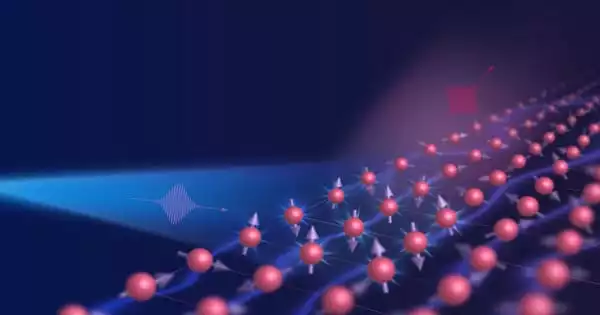According to a new study, electronic nematicity, which is thought to be a crucial component of high-temperature superconductivity, is largely spin-driven in the iron-based superconductor FeSe.
PSI’s Spectroscopy of Quantum Materials group, in collaboration with experts from Beijing Normal University, has solved a riddle at the forefront of iron-based superconductor research: the origin of FeSe’s electronic nematicity. They observed that, surprisingly, this electronic phenomenon is predominantly spin driven using Resonant inelastic X-ray scattering (RIXS) at the Swiss Light Source (SLS). Electronic nematicity is thought to be a crucial component of high-temperature superconductivity, although whether it helps or inhibits development remains unknown. Their findings were reported in the journal Nature Physics.
Near PSI, where the Swiss forest is ever present in people’s lives, you regularly see log heaps: wonderfully clean log piles. Wedge-shaped logs for firewood are carefully piled lengthwise but with little concern given to their rotation. A material is considered to be in a nematic condition when particles in it spontaneously line up, such as the logs in these log piles, breaking rotational symmetry while preserving translational symmetry. In a liquid crystal, this means that the rod-shaped molecules can flow like a liquid in the direction of their alignment but not in other directions. When the electron orbitals of a material align in this fashion, this is referred to as electronic nematicity. Typically, this electronic nematicity manifests itself as anisotropic electronic properties: for example, resistivity or conductivity exhibiting vastly different magnitudes when measured along different axes.
Since their discovery in 2008, the family of iron-based superconductors has sparked significant curiosity throughout the last decade. Along with the well-studied cuprate superconductors, these materials display the unexplained phenomenon of high temperature superconductivity. The electronic nematic state is a common property of iron-based superconductors. Yet, until recently, the physical basis of this electronic nematicity has remained a mystery; probably one of the most important mysteries in the research of iron-based superconductors.
But why is electrical nematicity so intriguing? The answer lies in the ever-exciting problem of knowing how electrons pair up and attain superconductivity at high temperatures. The story of electronic nematicity and superconductivity are intrinsically related, but how, and whether they compete or collaborate, is a contentious question.
The need to comprehend electronic nematicity has prompted researchers to focus on one specific iron-based superconductor, iron selenide (FeSe). FeSe is a bit of a puzzle, with the most basic crystal structure of any iron-based superconductor and the most perplexing electrical characteristics.
These findings shed light on the mechanism of electronic nematicity in FeSe, which has long been a mystery. But, more broadly, they contribute to a better understanding of electrical behavior in iron-based superconductors and, eventually, how this relates to superconductivity.
Thorsten Schmitt
FeSe enters its superconducting phase below a critical temperature (Tc) of 9 K, however it has an adjustable Tc, which means it may be raised by applying pressure on or doping the material. The quasi-2D layered material features an extended electronic nematic phase that emerges below around 90 K.
Surprisingly, this electronic nematicity does not appear to be accompanied by the long-range magnetic order that it would normally be associated with, sparking heated debate about its origins, specifically whether these are controlled by orbital- or spin-degrees of freedom. The lack of long-range magnetic order in FeSe allows for a better understanding of electronic nematicity and its interaction with superconductivity. As a result, many researchers believe that FeSe may hold the key to unlocking the mystery of electronic nematicity in the iron-based superconductor family.
Measuring the spin excitation anisotropies with Resonant inelastic X-ray scattering (RIXS)
Scientists from PSI’s Spectroscopy of Quantum Materials Group used resonant inelastic X-ray scattering (RIXS) at the Swiss Light Source’s ADRESS beamline to discover the origin of FeSe’s electronic nematicity (SLS). This approach, which combines the concepts of x-ray absorption and emission spectroscopies, is a highly efficient instrument for investigating the magnetic or spin excitations of a material.
“At PSI, we have one of the most advanced set-ups for RIXS in the world. Among the first to push this technique 15 years ago, we have now established a very well developed facility for this type of experiments,” explains Thorsten Schmitt, who led the study together with Xingye Lu from Beijing Normal University. “In particular, the characteristics of the synchrotron radiation due to the SLS ring design are ideal for the soft x-ray range that these experiments were performed in.”

The scientists had to overcome a practical barrier before they could examine the spin anisotropies of FeSe using RIXS. The sample had to be ‘detwinned’ before the anisotropic nematic behavior could be measured. Twinning occurs when crystals in stacked layers align with the same probability along arbitrary directions, masking any anisotropic behavior. Detwinning is a common crystallographic sample preparation procedure that involves applying pressure to the sample, causing the crystals to align along structural directions.
This does not work for FeSe. When this pressure is applied to FeSe, the soft material simply deforms – or breaks. As a result, the researchers developed an indirect detwinning process in which FeSe is attached to a detwinned material: barium iron arsenide (BaFe2As2). “When we apply a uniaxial pressure to BaFe2As2, this generates a strain of around 0.36 percent, which is just enough to detwin FeSe at the same time,” explains Xingye Lu, who previously demonstrated its feasibility for studies of FeSe with inelastic neutron scattering with Tong Chen and Pengcheng Dai from Rice University.
Inelastic neutron scattering experiments revealed spin anisotropies in FeSe at low energies, but high-energy spin excitation measurements were required to link these spin fluctuations to electronic nematicity. Measurement of spin excitations at an energy scale of roughly 200 meV – much above the energy separation between orbital energy levels – would rule out orbital degrees of freedom as a source of electronic nematicity. After successfully completing detwinning, the researchers were able to use RIXS to investigate the critical high-energy spin excitations of FeSe and BaFe2As2.
The researchers looked into spin anisotropy in the direction of the Fe-Fe bond. To assess spin anisotropy, the researchers detected spin excitations in two orthogonal directions and compared the results. The team was able to establish the crucial temperature at which nematic behavior ceased by performing tests under increasing temperature and comparing spin anisotropies to electronic anisotropies found through resistivity measurements.
The researchers utilized detwinned BaFe2As2 as a reference because it has a well-characterized anisotropic spin-structure and long-range magnetic order. Measurements of the spin excitation response in two orthogonal directions revealed a distinct asymmetry: the appearance of nematicity.
The team then repeated the experiment in detwinned FeSe. Despite the lack of magnetic ordering, they discovered a very significant spin anisotropy with respect to the two axes. “Extraordinarily, we could expose a spin anisotropy similar – if not larger – to that in the already extremely anisotropic BaFe2As2,” explains Xingye Lu. “This spin anisotropy reduces with increasing temperature and disappears around the nematic transition temperature – the temperature at which the material ceases to be in an electronic nematic state.”
The origin of electronic nematicity in FeSe: towards a better understanding of electronic behaviour in iron-based superconductors
The energy scale of spin excitations of roughly 200 meV, which is substantially larger than the spacing between orbital levels, demonstrates that electronic nematicity in FeSe is largely spin driven. “This was a big surprise,” says Thorsten Schmitt. “We could now make the connection between electronic nematicity, manifested as anisotropic resistivity, and the presence of nematicity in spin excitations.”
But what are the implications of these findings? A fundamental difficulty with unusual superconductors is the interaction of magnetism, electronic nematicity, and superconductivity. Quantum fluctuations of electronic nematicity are thought to induce high-temperature superconductivity in iron-based superconductors. These findings shed light on the mechanism of electronic nematicity in FeSe, which has long been a mystery. But, more broadly, they contribute to a better understanding of electrical behavior in iron-based superconductors and, eventually, how this relates to superconductivity. The next step will be to determine whether spin-driven electronic nematic behavior persists in other members of the iron-based superconductor family, and if suspicions that it can occur in directions other than the Fe-Fe bond axis are right.
















